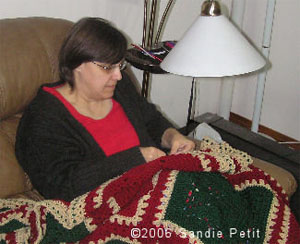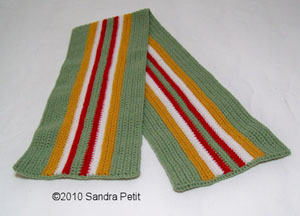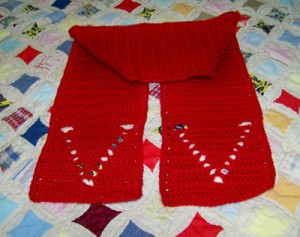This post contains affiliate links.
In the early 2000s, when I first learned to read crochet patterns, there weren’t many good crochet websites. One that I would visit time and again for help understanding a new technique was Crochet Cabana. Even now, as a crochet teacher I often refer beginners to this wonderful site. So I’m really excited to interview Sandie Petit today, the founder of Crochet Cabana.
Besides the Crochet Cabana website, you can find Sandie online on her blog, her Facebook page, her YouTube channel, her Etsy and Ravelry shops, and on Twitter. She is less frequently seen on Crafty Corral, her first crochet blog, and Tumblr. You can also buy Crochet Cabana items at Cafe Press. All pictures and logos are used with her permission.

Underground Crafter (UC): How did you first get started crocheting?
Sandie: In the summer of 1980, I went on vacation with some girlfriends in Mississippi. They pulled out their hooks and started crocheting and offered to teach me. That got the ball rolling. When I returned home the local TG&Y became my primary source for patterns, yarn, and hooks. The yarn was Sayelle at the time. For many years I thought Boye was the only kind of hook manufactured! With the advent of the Internet a whole new world opened up to me and I now have quite a nice hook collection! My house is often overrun by yarn and I have more patterns than I could complete in several lifetimes!

UC: What was the original inspiration behind Crochet Cabana?
Sandie: Crochet Cabana began in 1997 as a couple of pages on my personal website, Sandra’s Backyard. The original purpose was to have an area where I could jot down what I knew about crochet for my own reference. I also wanted to provide information for those just learning to crochet. I wanted to write it all down, with pictures, in a way that I hoped could be easily understood. All of my first tutorials were written with the new crocheter in mind. As I learned more myself – both in the field of crochet and also in web design – more was added.
In my wildest dreams I never imagined the site would get so large. As I got requests for information on this or that topic, I would add those topics also to the site. In 2001, my husband purchased a domain name for Crochet Cabana as a gift for me. Then in December 2004, we decided to purchase hosting space so I wouldn’t have to keep moving the site as it grew too large for the present host.

UC: Where do you generally find your creative inspiration?
Sandie: For designing, inspiration is everywhere. The world around you. Television. The Internet. Sitting in a doctor’s office or in traffic I might notice a particular color or pattern that is intriguing. Quite often it is a matter of need. I need a gift and I have xx amount of time (usually a very short window). It’s actually quite difficult to come up with something new and I always wonder if someone else has already done it. There are so many wonderful designers out there! I don’t feel that I do that much designing really, but when I post a picture of something I’ve worked up I know someone will ask for the pattern as soon as it’s posted.
As to inspiration for tutorials and videos, that generally comes from visitors to the site who inquire if I can show them how to do this or that. If enough people seem to be having the same problem or are interested in a particular technique, I consider adding it to the site. I do fairly often get requests for me to do a video or tutorial on how to work a particular pattern. That is something I cannot do because of copyright issues.
(One of Sandie’s videos. We start our foundation chain the same way!)
UC: You are a true pioneer of the DIY/craft scene on the internet. What were the benefits of establishing yourself online early, and what are some of the changes you’ve had to deal with in recent years?
Sandie: How nice of you to say! When I first began, I had no clue how to put up a website. My husband created the original site and showed me how to update it. Since then, I’ve done most of the work myself though my family, who are much more computer literate than I, have been a great help over the years. My daughter created the logo presently on the Cabana.
One of the benefits of being established so many years ago is that I can appreciate the technological advances available today. I clearly remember having to move the site over a dialup connection! What took many hours then would take mere minutes now. I am still using the same program to update the site (Microsoft Front Page). It is no longer supported so I will eventually have to find a new program to use – which is something I dread.
In those beginning days, way back when, one didn’t have to worry about Internet theft. In recent years, there has been a problem with people taking the work of others and claiming it as their own. Just a few months ago I found photos lifted from one of my tutorials on which the person had placed her own name right on the photos and put them on her site as her own. It was a foreign site and though I requested she remove them, that didn’t happen. You really have no recourse in these situations and it is quite discouraging since it is a lot of work to take photos, edit them, and add all the text to a tutorial, as well as making videos. Sadly, this has also happened to other designers. Sometimes you will even find people selling your patterns on Ebay, particularly if they are free patterns. They just copy them and sell them. It’s really terrible. In fact, I removed all the patterns I had on the site after one such incident. Since then, I’ve put a few back and opened Etsy and Ravelry shops. There are still quite a number I haven’t put up anywhere again. I am really torn about what to do as I love sharing my work with others. (UC comment: What a shame!)
Another change is that people are more and more moving to video teaching. I LOVE video teaching. It is amazing to me that I can create a video demonstrating how to do something, giving the tips I’ve learned through the years, and have someone in another country watch it and learn the technique. I guess I am showing my age here, but it just fascinates me. I often wish I had my own video studio and staff! I still have much to learn. I hope the industry doesn’t change too much while I’m learning!
Yet another change I have seen is the availability of e-books and e-patterns, both free and for sale. Being able to get a pattern you want immediately certainly has its up side. One thing I like about this is if I sell a pattern this way, I know exactly who purchased it and if I update it or find a significant error, I can let them know quite easily. Along with this is the self-publishing industry, such as Lulu, which has grown tremendously in the past few years.
The problem with all this availability is that much of it is free. This hurts the designers for whom crochet sales are a significant part of their earning power. I think this may be why we are seeing more complex designs as magazine publishers have to find a way to entice people to spend their discretionary income. It’s a dilemma I’m sure we will be addressing for some time to come as the industry works to find a balance between paper publishing and e-publishing.

UC: You do a lot of charity crochet. Can you tell us about some of your favorite charity projects, causes, and organizations?
Sandie: There are so many worthy organizations out there. I find that people generally gravitate toward a cause that is in some way meaningful to them. For example, I have lost many loved ones to cancer so if an opportunity arises I might donate to that cause. I had two preemies so I will occasionally donate preemie hats and afghans.
I also like to help out organizations that are based in my own state when I can. I also love to make scarves and squares. Those things came together for me in Scarves for Special Olympics where I could donate to the Louisiana branch of their organization. I was even able to deliver the scarves and meet the people there. That was rather exciting. They do require you to use particular brand and colors of yarn and there are size specifications, but I find that a challenge. I like to try and find different ways to make the scarves unique within those boundaries. This is an annual project so if you haven’t participated in the past you can always pick up and join in the next go round.
Then there is the National WWII Museum’s Knit Your Bit which is also located nearby and accepts scarves. I have had many family members in the military, including my son, and I am happy to be able to do something for the soldiers who put their lives on the line for us. Knit Your Bit gives a bit of a thank you to those soldiers. They accept any pattern, any color so it’s very easy to participate. Most of the vets are men so colors tend to lean in that direction.
I also like to be sure my work makes its way to the people for whom it was intended. With that in mind, I am cautious about sending to people I don’t know. I have known Sandy Holladay for many years and have no qualms about sending items to her for The Bridge and Beyond Project, which helps the homeless. She accepts many different items including scarves, mittens, and socks. She does amazing things with donated squares, putting together afghans which are then given to one of several local missions. Each day I am thankful that I have a roof over my head, clean clothes, and food to eat. It’s a shame there are so many who don’t have these basic needs met.
Heartmade Blessings has been around quite a number of years. They accept 12” squares which are put together into comfortghans. Several people I know personally have benefited from this effort. (UC comment: I’m actually working on several squares right now to donate to Heartmade Blessings as part of the Crochetlist March charity challenge.)
Crafting for a Cause is a wonderful group that supports our Native Americans. Most of the items made are sent directly to the reservation so you can be sure they are getting where they are needed.
In addition to official organizations, I like to donate where I can locally. As time goes on, postage costs for mailing packages has gone up so anything I can deliver is a plus.
That said, I occasionally like to send to SIBOL, way across the pond from me. I just love to go to Sue’s blog and Flickr page and see all the beautiful things. Everything is so artfully shown. She accepts 6” squares which are joined into lapghans for nursing homes in her area. Her challenges are fun too!

UC: You are a CGOA Master of Advanced Crochet Stitches and Techniques and a CYC Certified Crochet Teacher. Tell us why you decided to pursue these certifications and how/if they’ve been helpful to you.
Sandie: I am going to share with you my REAL reason for taking these courses. Shhhh. I never think my work is good enough and I thought that if I took these courses someone else could tell me if I was doing things correctly and, if not, I could learn the proper way. Having the certificates does not mean that I am a wonderful crocheter, but it does mean, to me, that I’ve run the course and persevered to complete it successfully. I may have a tiny bit more confidence than I had before since I did pass the courses.
I also thought that having the certificate would give a bit more weight to my qualifications as an instructor if I decided to teach community education classes or even paid classes through a craft store. (UC comment: I am also a CYC Certified Crochet Instructor and Teacher, and will actually be attending classes this weekend to become a CYC Certified Knitting Instructor and Teacher. For more discussion on the pros and cons of certification, see this post.)
The two courses are very different. I did learn some new techniques through my work on both courses, particularly the CGOA course because it covered more of a variety – like hairpin lace, which I’d not done a lot of before.
I find that every step you take is one step closer to your goal. You mentioned knitting. I’ve been trying to learn to knit for many years. I can cast on and I actually can knit, but if I drop a stitch, that is it for me. However, every time I try I get a little bit further in my understanding. It is the same with crochet. When I did the CGOA course, I did not work much with thread and I had to complete a filet thread project with thread, which I did successfully. I did not pick it up again until recently, but those things I learned at that point have come back to me and I find I just love filet!
I don’t know if the certificates mean anything to those who look at my work. I think your work really has to speak for itself. When I pick up a magazine or look online at a pattern I may purchase, I don’t know if that person has a certificate or not. I just like the pattern, the colors, and the way it was photographed, perhaps the stitches used or the yarn. I think taking the course was for me more than anything.
I would dearly love to take Pauline Turner’s course. I understand it is difficult and I think if I passed that one I would really feel like a crochet master.
UC: What are your favorite crochet books in your collection?
Sandie: There are so many! Those that jump right to mind are Quick and Cozy Afghans which I use quite a bit; the Vanna books, particularly Vanna’s Afghans A to Z; Donna Kooler’s Encyclopedia of Crochet
; and Margaret Hubert’s The Complete Photo Guide to Crochet
. I have dozens of pattern and reference books and leaflets though. That just scratches the surface. One of my recent purchases was Super Finishing Techniques for Crocheters
by Betty Barnden. Her Filet Crochet
book is great also.

UC: Do you have any favorite crochet websites/blogs to share?
Sandie: I don’t get around to the blogs as much as I used to, but here are a few that I visit often:
- Crocheting with Dee,
- The Crochet Dude,
- Crochet Concupiscence, and
- Sandy’s Space (and her other blog, The Bridge and Beyond, listed above in charities).
Generally, I look at my blogroll to see who has updated and I will visit the top five or ten of them and sometimes the sites they recommend in their blogroll.
After reading other interviews on your blog, I also started following Vashti. (UC comment: Thanks Sandie! I am honored to have you as a reader.)
Thanks so much for stopping by for an interview, Sandie!

1 thought on “Interview with Sandie Petit, founder of Crochet Cabana”